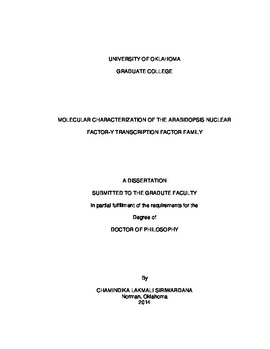| dc.description.abstract | NUCLEAR FACTOR-Y (NF-Y) transcription factors, composed of three independent families: NF-YA, NF-YB, and NF-YC, have greatly expanded in plants in comparison to animals. For example, while humans have only one member of each subunit, the modal plant Arabidopsis thaliana (Arabidopsis) has 10 members. However, due to lack of studies, the significance of the expansion in the plant lineage is poorly understood. Plant NF-Ys have primarily been studied on their role regulating flowering, abscisic acid (ABA) responses, embryogenesis, and nodulation in legumes. However, key questions remain on how the NF-Y regulates these processes. Here I answer two fundamental questions about the NF-YA subunit during regulation of ABA responses and flowering.
ABA mediated seed germination is one of the plant developmental responses regulated by the NF-Y. Three NF-YC subunits, NF-YC3, NF-YC4, and NF-YC9 have opposing responses during abscisic acid (ABA) mediated seed germination, demonstrating that members of this closely related gene family have evolved unique regulatory roles. Since the mature NF-Y complex binds DNA as a trimer I hypothesized that the NF-YA and NF-YB family members should also have opposing regulatory functions. However, opposing functions have not been identified for the NF-YA or NF-YB. In Chapter 2, I studied the germination responses of all 10 Arabidopsis NF-YA genes by creating overexpression constructs. Germination responses on ABA containing media showed that the closely related paralogs NF-YA1 and NF-YA9 are insensitive and NF-YA2, NF-YA4, NF-YA7, NF-YA8, and NF-YA10 were hypersensitive to ABA. The result supported my hypothesis and show that the closely related NF-YA family members have evolved opposing roles regulating ABA mediated seed germination.
The NF-Ys have been extensively studied during its regulation of photoperiod dependent flowering. NF-YB and NF-YC subunits are known positive regulators of this pathway, however the role of NF-YA subunits remained a fundamental question that had not been answered. Prior research had proposed a model where NF-YA acts as negative regulators of flowering. However, several recent publications demonstrated that NF-YA should be acting as positive regulators. In Chapter 3, I tried to understand the role played by NF-YA during floral regulation. My hypothesis was that NF-YAs are positive regulators of flowering. Since loss of function NF-YA are lethal or do not have flowering phenotypes, I used two approaches to test if NF-YA are positive regulators. First, to indirectly test if NF-YAs are need for the NF-YB/NF-YC dimer to regulate flowering, I created a mutant version of NF-YB that loses interaction with NF-YA. The mutant was overexpressed in the late flowering nf-yb2 nf-yb3 double mutant and was found not to complement the late flowering phenotype. However, the mutant protein was strongly expressed and was able to localize to the nucleus. This result strongly indicated that NF-YA should be required as positive regulators of flowering. My second approach was to study overexpressors of NF-YA. Here I was able to identify that NF-YA2 overexpressors drove early flowering and led to the upregulation of a key floral gene FT. These results strongly suggested that NF-YA2 might be a positive regulator of flowering. Further, a recent publication had demonstrated that CO provides an activation domain for the NF-Y complex. The NF-Ys were able to induce flowering in the absence of CO (in a co mutant background) when an activation domain called EDLL was attached to NF-YB2. I hypothesized that the NF-YB2 mutant that loses interaction with NF-YA will not be able to induce flowering, however NF-YA2 will be able to induce flowering in the absence of CO when attached to the EDLL domain. The results supported the hypothesis. As a conclusion, my data strongly suggests that NF-YAs are required as positive regulators of flowering.
In addition to studying the roles played during seed germination and flowering, I also studied protein interactions of the NF-Y and how the NF-Ys are regulated. In Chapter 4, I studied the protein-protein interactions of NF-YC9 and its targets. A combination of deletions and point mutations were used to understand how NF-YC9 interacts with its targets. The results demonstrated that while the conserved domain is required for protein function, the non-conserved regions are also necessary for the interaction between NF-YC9 and most of its targets. In Chapter 6, I have presented a collection of yeast 2-hybrid (Y2H) experiments done to better understand the nature of NF-Y protein interactions. This chapter demonstrated the NF-Ys are able to interact with a variety of other plant proteins including transcription factors. It also demonstrated inter-species protein interactions in plants. In Chapter 5, I studied the regulation of NF-YA transcript and protein. Here I was able to show that NF-YA family transcripts and proteins are regulated by light.
In conclusion this dissertation added to the literature on NF-Y in several aspects; 1) opposing role for the NF-Y were identified during seed germination, 2) NF-YA were strongly suggested to be positive regulators of flowering, 3) protein interactions of the NF-Y were dissected through Y2H analysis, 4) NF-YA transcripts and proteins were shown to be regulated by light. | en_US |
